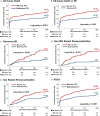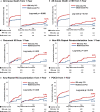Comparison of Long-Term Clinical Outcome Between Multivessel Percutaneous Coronary Intervention Versus Infarct-Related Artery-Only Revascularization for Patients With ST-Segment-Elevation Myocardial Infarction With Cardiogenic Shock
- PMID: 31818215
- PMCID: PMC6951086
- DOI: 10.1161/JAHA.119.013870
Comparison of Long-Term Clinical Outcome Between Multivessel Percutaneous Coronary Intervention Versus Infarct-Related Artery-Only Revascularization for Patients With ST-Segment-Elevation Myocardial Infarction With Cardiogenic Shock
Abstract
Background Data are limited regarding long-term outcomes in patients with ST-segment-elevation myocardial infarction and multivessel disease presenting with cardiogenic shock according to revascularization strategy. We sought to compare the 3-year clinical outcomes of patients with ST-segment-elevation myocardial infarction multivessel disease with cardiogenic shock and patients with multivessel percutaneous coronary intervention (PCI) and infarct-related artery (IRA)-only PCI. Methods and Results Of 13 104 patients from the nationwide, multicenter, prospective KAMIR-NIH (Korea Acute Myocardial Infarction Registry--National Institutes of Health) registry, we selected 659 patients with ST-segment-elevation myocardial infarction who had concomitant non-IRA stenosis and presented with cardiogenic shock. The primary outcome was all-cause death. Multivessel PCI was performed in 260 patients and IRA-only PCI in 399 patients. At 3 years, patients in the multivessel PCI group had a lower risk of all-cause death (adjusted hazard ratio, 0.65; 95% CI, 0.45-0.94 [P=0.024]), all-cause death or MI (adjusted hazard ratio, 0.59; 95% CI, 0.41-0.84 [P=0.004]), and non-IRA repeat revascularization (adjusted hazard ratio, 0.23; 95% CI, 0.10-0.50 [P<0.001]) than those in the IRA-only PCI group. The results were consistent after confounder adjustment by propensity score matching and inverse probability weighting analysis. Landmark analysis at 1 year demonstrated that the multivessel PCI group had a lower risk of recurrent MI and non-IRA repeat revascularization beyond 1 year (log-rank P=0.030 and P=0.017, respectively) than the IRA-only PCI group. Conclusions In patients with ST-segment-elevation myocardial infarction and cardiogenic shock, multivessel PCI was associated with a lower risk of all-cause death than IRA-only PCI at 3 years, suggesting potential benefit of non-IRA revascularization during the index hospitalization to improve long-term clinical outcomes.
Keywords: ST‐segment–elevation myocardial infarction; cardiogenic shock; complete revascularization; multivessel disease; outcomes; percutaneous coronary intervention.
Figures



Comment in
-
Interventional Treatment of Nonculprit Lesions in Infarct-Related Cardiogenic Shock.J Am Heart Assoc. 2019 Dec 17;8(24):e015045. doi: 10.1161/JAHA.119.015045. Epub 2019 Dec 10. J Am Heart Assoc. 2019. PMID: 31818217 Free PMC article. No abstract available.
Similar articles
-
Multivessel Percutaneous Coronary Intervention in Patients With ST-Segment Elevation Myocardial Infarction With Cardiogenic Shock.J Am Coll Cardiol. 2018 Feb 27;71(8):844-856. doi: 10.1016/j.jacc.2017.12.028. J Am Coll Cardiol. 2018. PMID: 29471935
-
Culprit Vessel-Only Versus Multivessel Percutaneous Coronary Intervention in Patients With Cardiogenic Shock Complicating ST-Segment-Elevation Myocardial Infarction: A Collaborative Meta-Analysis.Circ Cardiovasc Interv. 2017 Nov;10(11):e005582. doi: 10.1161/CIRCINTERVENTIONS.117.005582. Circ Cardiovasc Interv. 2017. PMID: 29146672 Review.
-
Fractional Flow Reserve-Guided Complete Revascularization Improves the Prognosis in Patients With ST-Segment-Elevation Myocardial Infarction and Severe Nonculprit Disease: A DANAMI 3-PRIMULTI Substudy (Primary PCI in Patients With ST-Elevation Myocardial Infarction and Multivessel Disease: Treatment of Culprit Lesion Only or Complete Revascularization).Circ Cardiovasc Interv. 2017 Apr;10(4):e004460. doi: 10.1161/CIRCINTERVENTIONS.116.004460. Circ Cardiovasc Interv. 2017. PMID: 28404623 Clinical Trial.
-
Multivessel Versus Culprit-Vessel Percutaneous Coronary Intervention in Patients With Non-ST-Segment Elevation Myocardial Infarction and Cardiogenic Shock.JACC Cardiovasc Interv. 2021 May 24;14(10):1067-1078. doi: 10.1016/j.jcin.2021.02.021. Epub 2021 Apr 28. JACC Cardiovasc Interv. 2021. PMID: 33933384
-
Meta-analysis of fractional flow reserve guided complete revascularization versus infarct related artery only revascularization in patients with ST-elevation myocardial infarction and multivessel coronary artery disease.Coron Artery Dis. 2019 Sep;30(6):393-397. doi: 10.1097/MCA.0000000000000740. Coron Artery Dis. 2019. PMID: 31094897
Cited by
-
2021 Korean Society of Myocardial Infarction Expert Consensus Document on Revascularization for Acute Myocardial Infarction.Korean Circ J. 2021 Apr;51(4):289-307. doi: 10.4070/kcj.2021.0043. Korean Circ J. 2021. PMID: 33821579 Free PMC article. Review.
-
When to Achieve Complete Revascularization in Infarct-Related Cardiogenic Shock.J Clin Med. 2022 May 31;11(11):3116. doi: 10.3390/jcm11113116. J Clin Med. 2022. PMID: 35683500 Free PMC article. Review.
-
Renal Impact of Culprit-Only versus Multi-Vessel Revascularization for Cardiogenic Shock Complicating Acute Myocardial Infarction: Systematic Review and Meta-Analysis.Acta Cardiol Sin. 2023 Nov;39(6):817-830. doi: 10.6515/ACS.202311_39(6).20230307A. Acta Cardiol Sin. 2023. PMID: 38022428 Free PMC article.
-
Fibrinogen-to-albumin ratio predicts long-term outcomes for patients with ST-elevation myocardial infarction and multivessel disease: A prospective observational cohort study.Exp Ther Med. 2021 May;21(5):465. doi: 10.3892/etm.2021.9896. Epub 2021 Mar 8. Exp Ther Med. 2021. PMID: 33767762 Free PMC article.
-
Does multivessel revascularization fit all patients with STEMI and multivessel coronary artery disease? A systematic review and meta-analysis.Int J Cardiol Heart Vasc. 2021 Jun 11;35:100813. doi: 10.1016/j.ijcha.2021.100813. eCollection 2021 Aug. Int J Cardiol Heart Vasc. 2021. PMID: 34169144 Free PMC article. Review.
References
-
- Abdel‐Wahab M, Saad M, Kynast J, Geist V, Sherif MA, Richardt G, Toelg R. Comparison of hospital mortality with intra‐aortic balloon counterpulsation insertion before versus after primary percutaneous coronary intervention for cardiogenic shock complicating acute myocardial infarction. Am J Cardiol. 2010;105:967–971. - PubMed
-
- Park DW, Clare RM, Schulte PJ, Pieper KS, Shaw LK, Califf RM, Ohman EM, Van de Werf F, Hirji S, Harrington RA, Armstrong PW, Granger CB, Jeong MH, Patel MR. Extent, location, and clinical significance of non‐infarct‐related coronary artery disease among patients with ST‐elevation myocardial infarction. JAMA. 2014;312:2019–2027. - PubMed
-
- Ibanez B, James S, Agewall S, Antunes MJ, Bucciarelli‐Ducci C, Bueno H, Caforio ALP, Crea F, Goudevenos JA, Halvorsen S, Hindricks G, Kastrati A, Lenzen MJ, Prescott E, Roffi M, Valgimigli M, Varenhorst C, Vranckx P, Widimsky P; ESC Scientific Document Group . 2017 ESC guidelines for the management of acute myocardial infarction in patients presenting with ST‐segment elevation: the task force for the management of acute myocardial infarction in patients presenting with ST‐segment elevation of the European Society of Cardiology (ESC). Eur Heart J. 2018;39:119–177. - PubMed
-
- Thiele H, Akin I, Sandri M, Fuernau G, de Waha S, Meyer‐Saraei R, Nordbeck P, Geisler T, Landmesser U, Skurk C, Fach A, Lapp H, Piek JJ, Noc M, Goslar T, Felix SB, Maier LS, Stepinska J, Oldroyd K, Serpytis P, Montalescot G, Barthelemy O, Huber K, Windecker S, Savonitto S, Torremante P, Vrints C, Schneider S, Desch S, Zeymer U, CULPRIT‐SHOCK Investigators . PCI strategies in patients with acute myocardial infarction and cardiogenic shock. N Engl J Med. 2017;377:2419–2432. - PubMed
-
- Neumann FJ, Sousa‐Uva M, Ahlsson A, Alfonso F, Banning AP, Benedetto U, Byrne RA, Collet JP, Falk V, Head SJ, Juni P, Kastrati A, Koller A, Kristensen SD, Niebauer J, Richter DJ, Seferovic PM, Sibbing D, Stefanini GG, Windecker S, Yadav R, Zembala MO. 2018 ESC/EACTS guidelines on myocardial revascularization. Eur Heart J. 2019;40:87–165. - PubMed
Publication types
MeSH terms
LinkOut - more resources
Full Text Sources
Miscellaneous

